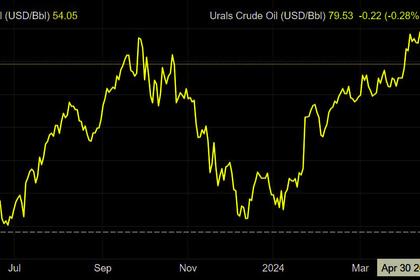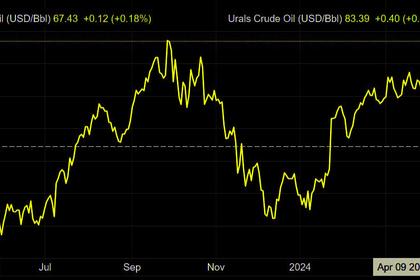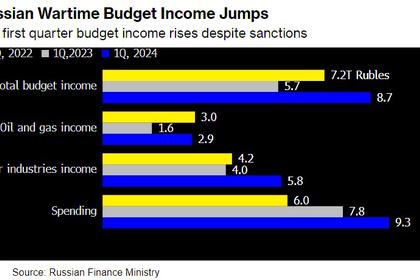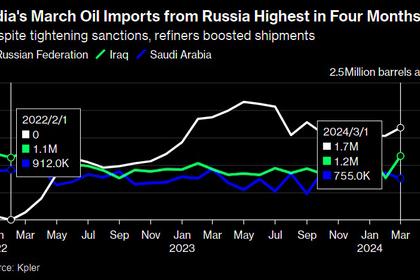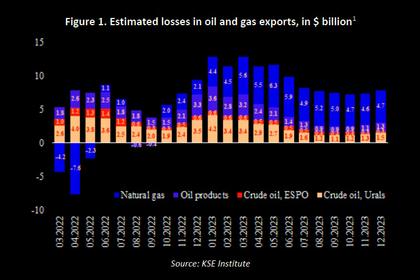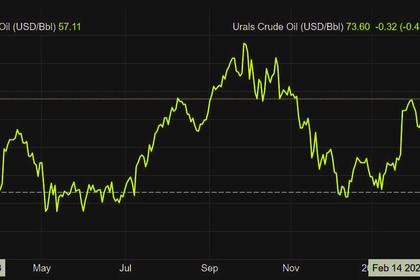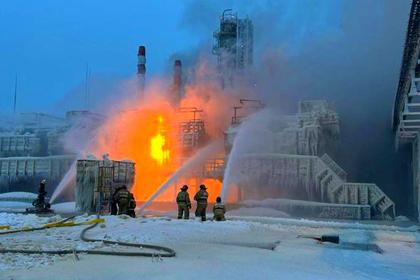
RUSSIAN DEMOGRAPHIC, ENERGY PROBLEMS
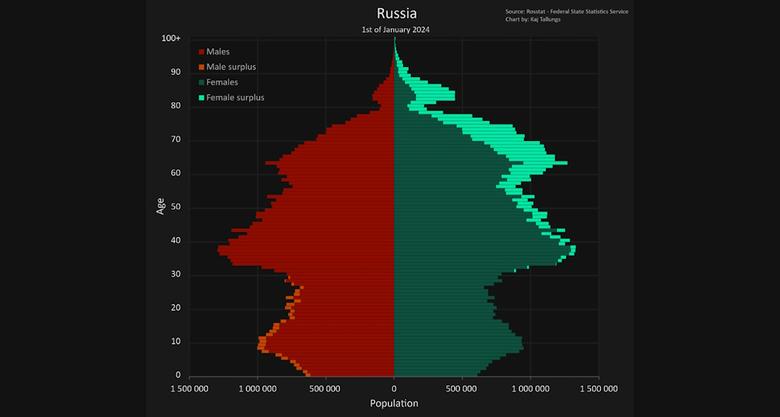
BLOOMBERG - May 6, 2024 - Russia’s oil and gas industry has been crucial for bankrolling the invasion of Ukraine, giving the Kremlin the funds to keep fighting even as the conflict drags on through its third year. But the industry is facing a shortage of manpower as the full mobilization of Russia’s economy for war exacerbates a longstanding demographic crunch.
In a nation where Gazprom PJSC’s “Dreams Come True” slogan has long summed up the career aspirations of many citizens, high-paying energy companies now find themselves having to compete for workers against the Russian army and weapons manufacturers, according to analysts and recruiters working with the industry. The sign-up bonus alone for a soldier fighting in Ukraine may be equivalent to nearly a year’s salary for an average oil and gas field worker.
This problem isn’t entirely new — Russia has faced a shrinking working-age population for almost two decades. The collapse in birth rates in the 1990s was a root cause and the Covid pandemic added to the challenge, but the invasion of Ukraine has made it much more acute.
Lack of personnel is now hitting businesses across all parts of the economy, according to recent reports from Russia’s central bank. While the oil and gas industry appears to be ticking along smoothly, there may be a longer-term impact.
“Staff shortages have affected even the wealthy industries,” said Alexei Zakharov, president of online recruiter Superjob.ru. “The oil and gas sector can afford to attract employees with higher salaries, but the state competes by offering military contracts.”
Russia’s oil and gas sector lacks some 40,000 employees this year, according to estimates from Moscow-based Kasatkin Consulting, formerly Deloitte’s research center in the region. The industry raised the number of online job listings in the first quarter by 24% compared to a year before, looking not just for qualified personnel but also low-skilled workers, show data from major Russian recruitment platform hh.ru.
“This industry has open vacancies for electricians, drivers, mechanics, welders, machinists, general workers, sales managers, design engineers, salesmen,” said Anna Osipova, head of regional external communications at hh.ru.
Russia’s Energy Ministry didn’t respond to Bloomberg request for comment.
The oil and gas industry has long been one of Russia’s highest-paying employers, offering a wage that exceeded the national average by at least two thirds since 2017, according to Bloomberg calculations based on data from the Federal Statistics Service. In January and February, the monthly nominal salary in the industry — including workers in oil and gas production, services, refining, pipeline shipments and storage — averaged some 125,200 rubles ($1,340).
That sum no longer competes with what the Russian army is offering to contract soldiers. In addition to the flat nationwide sign-on bonus of 195,000 rubles, each Russian region offers its own one-time payment to a new recruit, rising to as much as 1 million rubles.
“Competition with salaries in the armed forces and military industrial complex has certainly had an impact,” on workforce availability for the Russian oil and gas industry, said Dmitry Kasatkin, a partner at Moscow-based Kasatkin Consulting.
If a worker doesn’t want to fight in Ukraine - where the UK Ministry of Defence estimates more than 450,000 Russian soldiers have been killed or wounded since President Vladimir Putin decided to invade in February 2022 — there are also lucrative contracts available with military manufacturers. Demand for tanks, armored vehicles and weapons has soared and arms factories have been searching for workers in the tight labor market.
Last year, Russia’s state defense corporation, Rostec, raised salaries by an average 17.2%. “We still need people,” Chief Executive Officer Sergey Chemezov told Vladimir Putin in August. “Many of our facilities have been working on the weekends, on bank holidays, and at night.”
Demographic Crunch
Putin’s decision to mobilize Russia’s economy for war has worsened a longstanding demographic problem.
In the 1990s, the economic turmoil after the breakup of the Soviet Union sent fertility rates plunging. Between 2007 and the end of 2021, the nation’s working-age population shrank by 5.8 million people, according to statistical data. The pandemic exacerbated the issue. From 2020 to 2022, almost 750,000 people died in Russia with Covid-19 listed as the main cause, according to Federal Statistics Service data.
The share of employees under 30 years in the Russian labor market dropped to 14.9% in 2022, the lowest since early 1990, according to estimates of audit and consulting firm FinExpertiza.
Another consequence of Russia’s military aggression against Ukraine has been to limit the flow of laborers from abroad. International sanctions have weakened the ruble, boosted inflation and complicated international money transfers, making Russia less attractive for migrants from ex-Soviet countries. Last year, the official net inflow of foreign migrants into the country was almost 110,000 people, just a quarter of the level in 2021, the last year of statistics before the war started.
That level of immigration is just a drop in the ocean compared with Russia’s demand for labor. At the end of March, the nation needed 1.86 million extra workers, according to data from Federal Statistics Service based on companies’ requests to job centers.
Employee Perks
“The northern regions are starving for more workforce, there are just not enough people,“ said Denis, a 41 year-old who left the Russian energy industry last August to pursue another career in Moscow.
As salaries alone are not enough to attract a new workforce, Russian oil and gas companies, which often run their core operations in remote areas with harsh climates, have been offering further perks.
A field worker doing monthly shifts somewhere in Siberia or the Arctic can expect “hot meals three times a day” and regular medical check-ups covered by the employer, according to job listings at hh.ru. Some employers also throw in Soviet-style incentives such as “New-Year presents for kids” and trips to corporate resorts, according to recent listings on the site.
To widen the circle of potential employees, some companies have introduced a policy of “bring your friend and get paid,” offering around $50 to $100 per new hire. That’s not much by western standards, but in Russia it’s enough to buy the minimum level of food necessary for one person for a month.
All those perks are still not enough to lure the most desirable young skilled workers to the energy industry. That’s forcing companies to turn to older workers.
“The oil industry used to encourage people to retire on time — You are close to the retirement age? Here’s a big bonus for you and we’ll see you off with honor, to make room for the younger generation,” said Superjob.ru’s Zakharov. Now the companies are phasing these programs out and encouraging the personnel “to work as long as possible,” he said.
Key Industry
Since the invasion of Ukraine, Russia’s oil and gas sector has been targeted by an ever-tightening net of international sanctions designed to curb the flow of petrodollars. Yet the industry has continued to operate smoothly, giving Moscow the funds needed to keep sending soldiers to the front line and purchase weapons to attack Ukrainian cities and infrastructure.
Last year’s oil-production drilling rates set a post-Soviet record, while Russia’s crude exports remain robust even as the country makes output cuts in partnership with the Organization of Petroleum Exporting Countries. The country’s natural gas production is rebounding after a sharp drop in 2022 and 2023 when pipeline flows to Europe were mostly halted. The government expects pipeline exports of the fuel to recover by almost a fifth this year due to higher flows to China.
The labor shortages raise questions about whether Russia’s oil and gas industry can sustain this performance in the longer-term.
“Restricted access to Western high-tech oil services creates a risk for maintaining and increasing profitable production and refining of oil and gas,” said Sofia Mangileva, an analyst at Moscow-based consultant Yakov & Partners. “The lack of qualified personnel aggravates this challenge, since the task now is not only to operate the equipment, but also to develop our own technologies.”
-----
Earlier:
